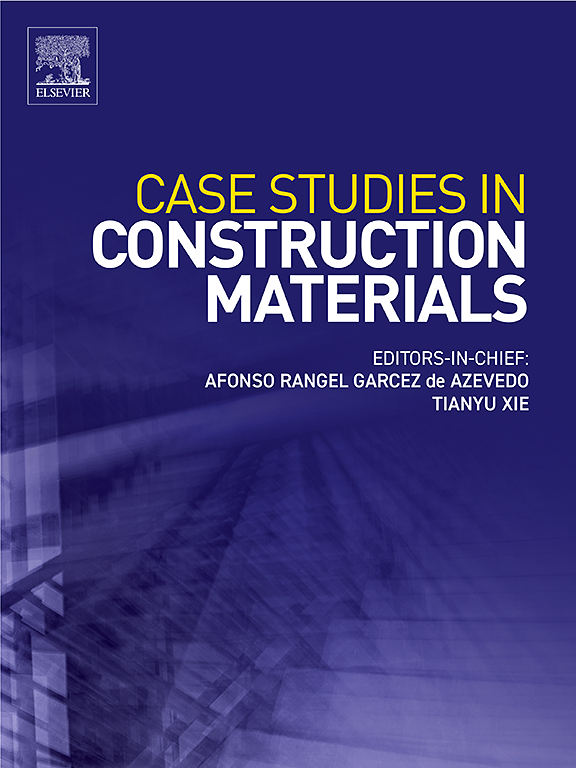Performance enhancement and mechanism analysis of low-carbon cement-stabilized macadam based on vibratory mixing method
IF 6.6
2区 工程技术
Q1 CONSTRUCTION & BUILDING TECHNOLOGY
引用次数: 0
Abstract
The cement-stabilized macadam (CSM) base demands a large amount of cement. However, cement production results in high energy consumption and CO2 emissions, thereby posing a threat to the environment. Thus, it is essential to seek solutions to reduce CSM cement usage. Uneven cement dispersion in CSM leads to premature pavement distresses and cement waste. The mixing process becomes a crucial factor to dispersion. This study investigates the performance enhancement mechanism of CSM under different mixing processes (static and vibratory mixing) and cement dosages. The unconfined compressive strength of CSM under various cement dosages and two mixing conditions was evaluated. The indirect tensile strength, dry shrinkage, temperature shrinkage, and anti-scour properties of CSM with the same cement dosage but different vibratory mixing conditions were investigated. The microstructure and cement dispersion uniformity in CSM were analyzed via SEM and EDTA testing. Results show that vibratory mixing destroys cement agglomeration through high-frequency elastic waves, strengthens the interfacial transition zone and improves the mixing efficiency in low-efficiency area, promoting uniform distribution of cement hydrated products and aggregates. Compared with static mixing, it increases unconfined compressive strength by over 20 % under different cement dosages, and leads to improvements in the indirect tensile strength, dry shrinkage, temperature shrinkage, and anti-scour performance of CSM with the same cement dosage. The vibratory mixing process can ensure that the performance remains stable while reducing the cement consumption. It is capable of cutting down carbon emissions and energy consumption, thus being a promising and low-carbon construction method.
基于振动搅拌法的低碳水泥稳定碎石增强性能及机理分析
水泥稳定碎石基层需要大量的水泥。然而,水泥生产导致高能耗和二氧化碳排放,从而对环境构成威胁。因此,寻求减少CSM水泥使用量的解决方案至关重要。水泥在水泥混凝土中的分散不均匀导致路面过早破损和水泥浪费。混合过程是影响分散的关键因素。研究了不同搅拌工艺(静态搅拌和振动搅拌)和水泥掺量下CSM的性能增强机理。对不同水泥掺量和两种搅拌条件下CSM的无侧限抗压强度进行了评价。研究了相同水泥掺量、不同振动搅拌条件下CSM的间接抗拉强度、干收缩、温度收缩和抗冲刷性能。通过SEM和EDTA测试分析了CSM的微观结构和水泥分散均匀性。结果表明:振动搅拌通过高频弹性波破坏水泥团聚,强化界面过渡区,提高低效区的搅拌效率,促进水泥水化产物和骨料的均匀分布;与静态搅拌相比,不同水泥掺量下CSM的无侧限抗压强度提高20% %以上,在相同水泥掺量下CSM的间接抗拉强度、干收缩、温度收缩和抗冲刷性能均有改善。振动搅拌工艺在保证性能稳定的同时,降低了水泥用量。它能够减少碳排放和能源消耗,是一种有前途的低碳建筑方法。
本文章由计算机程序翻译,如有差异,请以英文原文为准。
求助全文
约1分钟内获得全文
求助全文
来源期刊

Case Studies in Construction Materials
Multiple-
CiteScore
7.60
自引率
19.40%
发文量
842
审稿时长
63 days
期刊介绍:
Case Studies in Construction Materials provides a forum for the rapid publication of short, structured Case Studies on construction materials. In addition, the journal also publishes related Short Communications, Full length research article and Comprehensive review papers (by invitation).
The journal will provide an essential compendium of case studies for practicing engineers, designers, researchers and other practitioners who are interested in all aspects construction materials. The journal will publish new and novel case studies, but will also provide a forum for the publication of high quality descriptions of classic construction material problems and solutions.
 求助内容:
求助内容: 应助结果提醒方式:
应助结果提醒方式:


